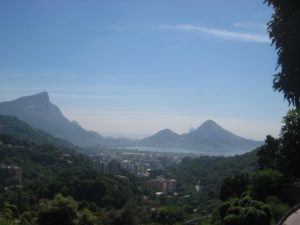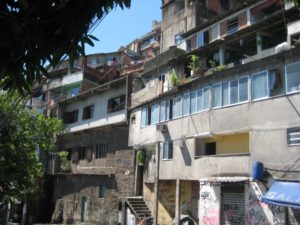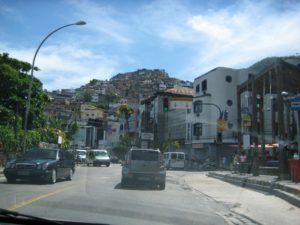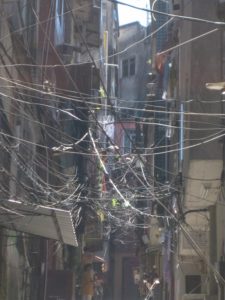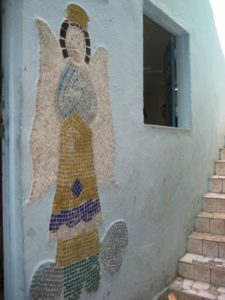Favela (Brazilian Portuguese for slum) is the generally used term for a slum in Brazil according to Wikipedia. Slums exist throughout the world, but the ones in Rio de Janeiro have gathered the most attention in recent years. What makes the slums of Brazil different from slums elsewhere? And why do they attract so much attention?
On a recent trip to Rio de Janeiro, I decided to see for myself what goes on inside the slums of Rio de Janeiro. What I saw surprised me, enlightened and encouraged me. To gain access to the favelas, I erred on the side of caution and went with a small group and a local guide who had family members who had lived in the slums.
Coming from Boston where the downtown and vicinity contains a population of about 350 – 400 thousand people, less than a million people at any rate, cities in Brazil seem … overwhelming in scale. Most cities in Brazil tend to have about 16 or 17 million people. In Rio de Janeiro, we visited two favelas, Rocinha and Vila Canoas. Rocinha has a population close to a quarter million people!
What strikes me the most each time I visit Brazil is how visible the favelas are from the upscale tourist sections of town. In many American cities, slums are hidden near highways, abandoned areas, or located on the outskirts of town. In Rio – the favelas are in prominent view from downtown Copacabana and Ipanema and from many of the most expensive resort hotels. In other words – in Rio, the poor man lives on top of the hill.
We went up the hillsides surrounding Rio on our way to the first favela – Rocinha, the largest favela in Rio de Janeiro. I was nervous and full of anticipation – I didn’t really know what I was getting into. As we stopped the van, we got out and were met by local artists selling their wares on the side of the road. Warm smiles and beautiful crafts greeted us. Some of the local artists were painters and had created interesting canvases depicting life in the favela, while others had focused on the beauty of the landscapes around Rio. Men and women had used natural materials to fabricate these wonderful products for us to purchase. These these warm friendly artists, residents of the favela, made an impression on me and melted my fears about being in the favela.
Contrary to my expectation, the slum is a working city, not an area where people are just hanging out causing trouble. Most residents hold jobs, many of them in the wealthier sections of Rio. In the favela we visited a house of a successful engineer and his family, and the house looked very similar to other houses I saw in chic Ipanema. The slum has viable working neighborhoods and the guide informed us that many of the people living in the favela stayed there even after earning enough money to move out of the favela – mainly due to family ties.
Unlike the slums in many US cities, the favelas in Brazil have many services provided by the government – free for the residents, which may include water, sewer, electricity, and telephone service. Part of the reason for offering these basics is to help prevent the spread of disease (clean water to prevent a cholera epidemic, for example). Bus service also helps the residents to be able to get to and from work, since most of the favelas are located in hilly areas quite a long walk from the downtown neighborhoods.
A self-contained city offering shops, repair services, medical clinics, restaurants, schools, and churches, the favela was alive with human activity and constant bustle. Residents who do not work in other parts of Rio often work right in the favela. As we wandered the narrow streets we were constantly greeted by local shopkeepers and restaurant owners, where we purchased food and drinks.
Next we visited another favela, Vila Canoas, and went to the local school there. Children were everywhere – playing, drawing, filling out notebooks. They were jovial and smiling, full of energy. This made me hopeful that these children might grow up with an education at least, enabling them to have choices in life, maybe even a future.
Yet despite all the services offered in the favela, actually the main disadvantage is for the children born in the favelas. Schools do exist in the favelas; and in fact, residents have vocational and technical college courses available to them at no cost. However, the quality of education in the favela is usually not equal with education in other parts of the city so students are at a disadvantage when taking college entrance exams – which determine which colleges they can attend. The better universities in Brazil have steep entrance requirements (like test scores) and the best ones are usually the cheapest, but the hardest to get into. Students from wealthier areas are therefore more likely to gain access to the best schools and pay the least for these schools.
Another huge stumbling block for youth in the favela is the prevalence of drug trafficking and crime. Drug lords and other criminals often control the streets and there is little or no police intervention. Until these problems can be eradicated from the favelas, the youth will have difficulty staying out of crime and attaining success in life.
Is there hope for the future of these kids and adults living in the favela? Maybe … with cautious optimism.

Beth Hynes is a computer systems trainer who has also taught English as a Second Language to business professionals who need English for their professional development. Teaching in an international environment has provided her with cultural experience that best matches her global passions and interests. She speaks French fluently, some German and Italian and is on her way to learning Spanish.

